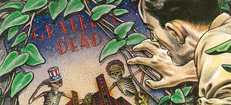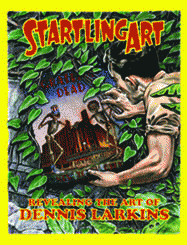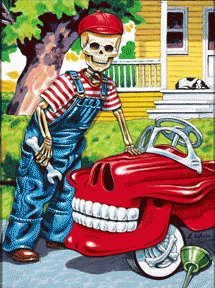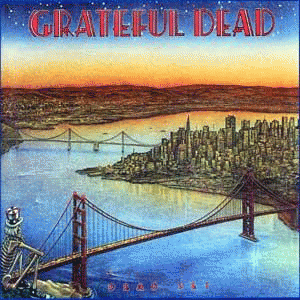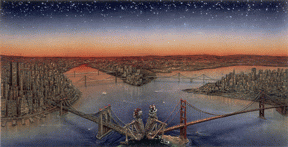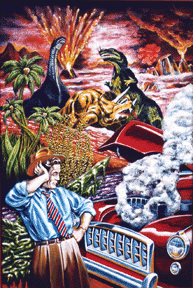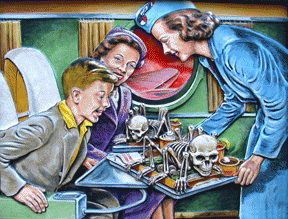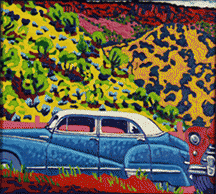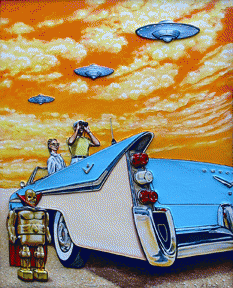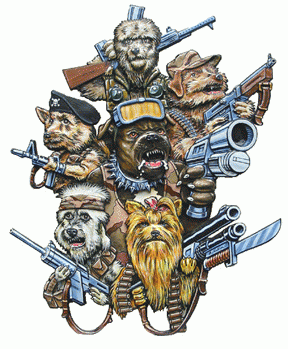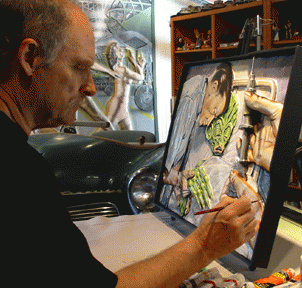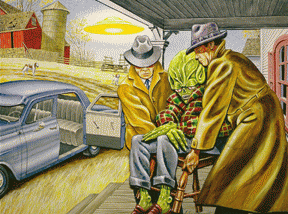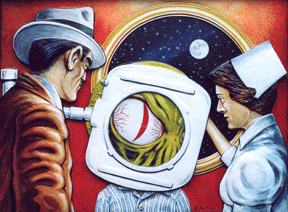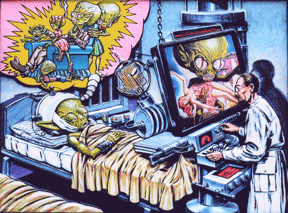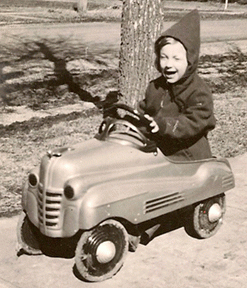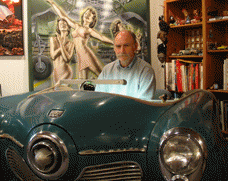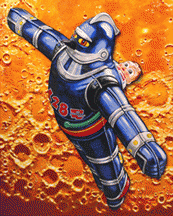Dennis Larkins' staggering output of artwork ranges from "lowbrow" pop surrealism paintings to stage design for rock concerts to his legendary series of Grateful Dead posters.
His newly released "Startling Art: Revealing the Art of Dennis Larkins" (2010, Last Gasp) is a wickedly fun romp through four decades of his unique, retro-kitsch mix of audacious archetypes, savvy satire and engaging images of vintage paraphernalia.
Planes, Trains, and Automobiles
If your elementary school education included diving under your desk for "duck and cover" drills, you'll feel right at home in Larkins' Atomic Age world of shiny-faced salesmen, high-heeled housewives, and vehicles of mass attraction.
His humor slithers along the scale from light to dark as he breathes mature life into his growing-up-in-the-50's visions. Vintage trains, planes, and automobiles join flying saucers, little green men, skeletons and explosives in his sci-fi- and pulp- inspired settings.
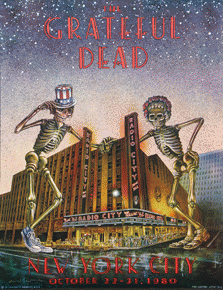
Grateful Dead Poster: Radio City Music Hall Illus. by Dennis Larkins
(Image by c. D. Larkins/P. Barsotti/GDP used with permission) Details DMCA
Grateful for the Dead
Early in his career, Larkins was in the right place at the right time to be invited to create artwork for the Grateful Dead, including his well known--and now, highly collectible--Grateful Dead Radio City Poster (1980). Among the other art Larkins created for the group is the "Dead Set" album cover. The front of the cover featured Larkins' iconic Grateful Dead skeleton, Sam, surveying the Golden Gate Bridge; the back of the cover showed his counterpart, Samantha, looking over the Manhattan skyline.
When the New York Historical Society mounted a Grateful Dead show in early 2010, they commissioned Larkins to design their poster, 35 years after creating his first artwork for the group.
The Yin and The Yang of It All: Opera by Day, Rock by Night
Painting sets for the San Francisco Opera was his day job, but Larkins moonlighted as designer and scenic artist for promoter, Bill Graham's famed "Day on the Green" (D.O.G.) music festivals, pioneering revolutionary rock stage sets.
These included the sets for the original legendary "Monsters of Rock" D.O.G. festival (1979), featuring Aerosmith, Ted Nugent, and AC/DC.
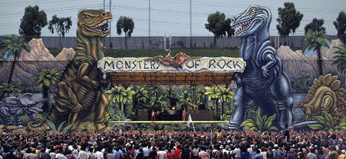
Monsters of Rock set, Day on the Green, 1979. Photo c. Baron Wolman
(Image by designed by Dennis Larkins) Details DMCA
Yes, Virginia, there is a dinosaur -- or, at least, real tyrannosaurus rex artwork that towers over 6 stories high!
The Rock and Roll Circus "D.O.G" (1979) featured Journey.
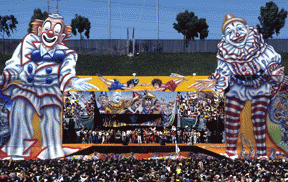
Rock & Roll Circus set, Day on the Green, 1979. Photo c.: Baron Wolman.
(Image by designed by Dennis Larkins) Details DMCA
Larkins' Stonehenge inspired set was created for Led Zeppelin (July 23-24, 1977), in what would prove to be their last American concert.
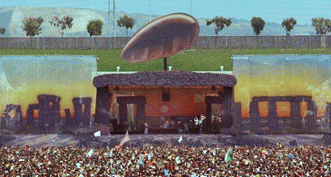
Led Zeppelin set, Day on the Green, 1977. Photo c.: Richard McCaffrey
(Image by designed by Dennis Larkins) Details DMCA
Larkins' designs were strikingly innovative in the wake of the bare stage sets of the 60's. He also created sets for the Rolling Stones, the Eagles, Foreigner, and many other legends of 70's rock.
Some of Larkins' sets enjoyed repeated use, such as the one he created for Santana's "Shango" tour. But most of his sets were transitory, albeit monumental, works of art--constructed in two weeks or less, used for a day or two, and later destroyed, lost, or otherwise damaged.
What remains are the audiences' purple-hazed memories, a few photos, and the lasting influence Larkins has had on today's elaborate rock 'n roll stages.
Son Makes Pop's Art Pop!
The text of Startling Art is brilliantly written and presented in a tongue-in-cheek, "high security dossier" storyline by Larkins' author-son, David.
The scrapbook-style layout features typewritten letters, scribbled notes, and telegrams exchanged between time-traveling secret agents investigating the artist and his works.
Larkins the Younger's editorial touch easily seduces the reader down the yellow brick road and directly into the poppy field of his father's multi-dimensional world.
We're Not In Kansas, Anymore
Larkins has come a long way, baby, from being born the son of a Kansas preacher to becoming the father of some of the most iconic images in the hallowed kingdom of rock "n roll. His kinetic, energetic imagery cavorts across his canvases and lands right in the baby boomer's soul. Amen.
Larkins started out painting calmer landscapes, reminiscent of Van Gogh mellowed out by a couple of vintage hash brownies.
But wacky things started bubbling up in his landscapes like unexpected volcanic eruptions. And the next thing you know, you're slip-sliding away down his wily time tunnel, smack into a three-way Technicolor video call with Disney, Dali, and Hieronymus Bosch.
If You're Not Living on the Edge, You're Taking Up Too Much Room
It's hard to find exactly the right label for Larkins' art, even among a plethora of labels for cutting edge artistic movements.
He is not your basic "nonconformist, just like everybody else."
The genre in which Larkins' art loosely fits is Pop Surrealism, an underground art movement that started rumbling in Los Angeles in the late 70's and early 80's.
Merriam-Webster defines the surrealistic art movement of the 1920's as "the principles, ideals or practice of producing fantastic or incongruous imagery or effects " by means of unnatural or irrational juxtapositions and combinations." Now add an assortment of elements from pulp and punk aesthetics, hot-rod street culture, underground comix, and a dash of humor and you've got Pop Surrealism.
Just think pimped-out folk art on steroids.
One of the first midwives of the style was a gallery that represents Larkins, La Luz de Jesus Gallery in Los Angeles. It's owned by Billy Shire, hailed as "the Peggy Guggenheim of Lowbrow," by JUXTAPOZ Magazine.├ éČ Ę
The "Lowbrow" label was a joke at first, and the name stuck. Some denounce it--perhaps they've forgotten that the name "Impressionists", which commands reverence today, was first applied to the works of Monet and friends as a derogatory comment in a scathing review of their work.
Larkins is clearly on the cutting edge of the cutting edge of the avant-garde. Out there.
Far out, man.
I Never Metaphor I Didn't Like
The layers of meaning in the symbol, metaphor and cultural archetypes of Larkin's art all dance in unison as they mouth the words, "what is real for you, what is meaningful?" They inspire personal romps across each viewer's inner landscape.
Larkins states that his work is an exploration of the "mysteries of our common life experience, including the poignancy of death and destruction, (and) also principles of rebirth, wonder, absurdity, exhilaration and creative freedom. The dichotomy between all of these aspects, and more, being simultaneously present (and available to experience) in each moment is a thematic thread that consistently runs through my work."
Oh, What a Relief it is!
Larkin's sculptural painting surface offers textural excitement that is not apparent in the 2-D images in the book. He molds and carves rubber, foams, and plastics to achieve a low relief sculpture on the canvas, for playful, 3-D effects as he creates the illusion of a scene that the viewer can feel fully immersed in.
This sculptural surface can be seen in this side view of one of the paintings in his Alien Abduction series:
Alien Abduction is a tale in five paintings with the first image depicting the unfortunate alien ironically being abducted by earthlings.
The second panel, "More than Meets the Eye" appeared in the movie "17 Again" (2009, New Line Cinema). It's hanging on the wall in quirky Ned Gold's (Thomas Lennon) house, during the scuffle scene with young Mike O'Donnell (Zac Efron).
The third painting in the series shows how the two characters in the scene each perceive the situation: while the alien simply longs to be relaxing at home with the family, he is viewed by the scientist as a terrorist.
The remaining two panels, "An Overriding Misunderstanding," and "Fearborne Pathogens" complete the story, and can be seen in Larkin's book, where all five panels are shown as a consecutive grouping for the first time since their completion.
And The Wheels Go 'Round and 'Round
Larkins comes full circle behind the wheels of his imagination, from his patchwork boyhood visions of the realities and mysteries of the Atomic Age and the Cold War, to the creation of a mature, humorous concoction of vintage kitsch and contrasting archetypes that inspire life's big questions.
Clearly Larkins is just visiting this planet, but we're glad he decided to stick around to entice us mere earthlings with his startling art.
Back to the Future Again
Larkin's book is absolutely essential for your circa 1955 kidney shaped coffee table, and furthermore, it is perfect for startling holiday gift giving. "Startling Art: Revealing the Art of Dennis Larkins" (2010, Last Gasp) is available at Amazon, Borders, Barnes and Noble.
Larkins website: www.startlingart.com
Dennis Larkins is represented by Jennie Cooley Gallery in Santa Fe, NM, and by La Luz de Jesus Gallery in Los Angeles, CA.
His work is currently on exhibit at the Russeck Gallery in SoHo, 478 W. Broadway, NYC, through October.
Irony Supplements: Startling Larkins Art Trivia
Collectors of Larkins' startling art include John Malkovich, Cheech Marin, Don Henley, and Morgan Spurlock. Somehow I'm not surprised.
Larkins created a 20' scenic painting for "The Men Who Stare at Goats" (with George Clooney) which can be seen in the background in a number of scenes in a classroom of the New Earth Army.
Larkins has done graphic design and illustration for the The Who, New Kids on the Block, Charlie Daniels Band; Bruce Springsteen; Simon and Garfunkel; Police; David Bowie; and many others.
Larkins is a former Walt Disney Imagineer and creative producer for Sega GameWorks.
He created Motor World brand toy cars (see his website for more info.)
Larkins has done a number of illustrations for New Mexico magazine, most recently in the Oct 2010 issue (page 42-45).
He designed the Kodak/Disney "Kodak Gallery Post Show" in the Kodak Pavilion, Epcot, Walt Disney World.
He was Production Designer for the "Honey, I Shrunk the Kids" playground at MGM/Studio Tour, Walt Disney World.
He was Lead Designer for the "Bug's Life" exhibit at Disneyland Innoventions (1998)
He was scenic artist on the feature films "Batman Returns" (Warner Bros. Studios) and "Honey I Blew Up the Kid" (Walt Disney Studios.)
Larkins' art can also be seen in the following books:
Les Barany's Carnivora: The Dark Art of Automobiles (2007. Barany Books/Scapegoat Publishing)
I Am 8-Bit (2006. Chronicle Books)
Grateful Dead: The Illustrated Trip (2003. DK Adult)
The Art of Rock (1987. Abbeville Press)
Notes on image: Grateful Dead Poster: Radio City Music Hall illustrated by Dennis Larkins is D. Larkins/P.Barsotti/GDP. concept by D. Larkins/P.Barsotti



